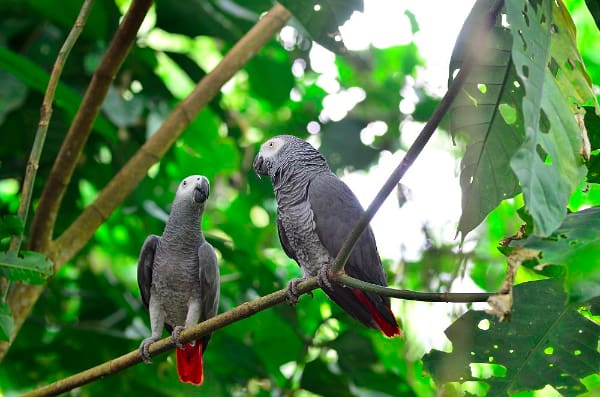Grey Parrots: Conservation Fieldwork
Status:

Collaborators/Funders:
Lukuru Foundation, Knoxville Zoo, Kenya Wildlife Service, Pandrillus Foundation, Last Great Ape Organization, Limbe Wildlife Centre, Lwiro Primate Rehabilitation Centre, Uganda Wildlife Education Centre, Disney Wildlife Rapid Response, Born Free Foundation, WWF Cameroon, Natural Encounters, Inc., Dees Family Foundation, Phoenix Landing Foundation, Columbus Zoo, Woburn Safari Park, Humane Society of the US (HSUS), Isdell Family Foundation, RSPCA, Pro Wildlife, Pan African Sanctuary Alliance (PASA), Ngamba Island Chimpanzee Sanctuary, Wildlife Conservation Society-Congo, Uganda Wildlife Authority, Bulgarian Ministry of Environment and Waters, MAYA, World Animal Protection (WAP)
The World Parrot Trust is leading or supporting new studies to collect updated data on the status of Grey Parrots (Psittacus erithacus) in the wild. Partnering with the Natural Encounters Conservation Fund, the WPT will support research in Uganda that is uncovering the ecology, anthropogenic threats, people’s perception and conservation status of Grey Parrots in Mukono district, Uganda. Funding will help cover costs for community-based monitoring equipment, allowances for the monitors, focus group discussions and awareness meetings on the threats facing the parrots.
WPT’s Nigeria Coordinator Ifeanyi Ezenwa conducted extensive research into the socio-economic dimensions of trade and trade routes for live parrots and parrot parts. The project culminated in a workshop bringing together stakeholders from government, law enforcement, academia and NGOs in Nigeria and Cameroon.
In a WPT-Natural Encounters (NECF) supported project, a researcher from London Southbank University is a researcher is uncovering Grey Parrot ecology, conservation status and people’s perceptions of the birds on Koome Island in Uganda. He mobilised communities, Mukono District Environment Officers, leaders and wildlife monitors to attend an awareness event for 150 people, drawing attention to the issues afflicting Greys. The workshop also provided residents with a means to exchange experiences and views on Greys, and their expectations from the meeting. Ssemambo and his team learned why the parrots are at threat, and that livelihoods for poor people living around the forested areas are being severely affected. Workshop participants learned of the potential positive impacts of conserving parrots, including ecotourism, participation in research studies and restoring forests for the benefit of people and wildlife. At its conclusion, a group of 10 farmers was selected to begin reforesting the area by planting over 160 native tree seedlings along the forest boundaries of Koome Village.
The team also trained select community monitors to use survey tools and data collection procedures. These monitors were taught Grey Parrot behaviour, ecology, habitat and diet.
IUCN/CITES Status: Endangered / Appendix I
Population: As few as 560,000, decreasing.
Range: Grey Parrots are found in S Nigeria, S Central African Republic, Republic of Congo, DRC, Gabon, Equatorial Guinea, SE Ivory Coast, N Angola, S Democratic Republic of Congo, NW Tanzania, W Kenya, W Uganda, Principe and Bioko Islands.
Natural history: Seen in primary and secondary rainforest, clearings, mangroves, wooded savanna, cultivated land and gardens to an altitude of 2200 m (7216 ft). Diet includes fruits and seeds, particularly oil palm fruit. Flocks roost in palms over water or on islands in rivers. Breeding is January-February and June-July, E Africa; in other areas the dry season. Nest is a cavity in a tall living tree.
